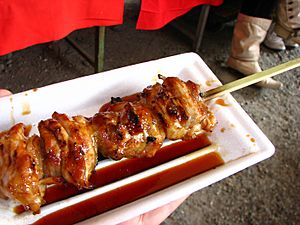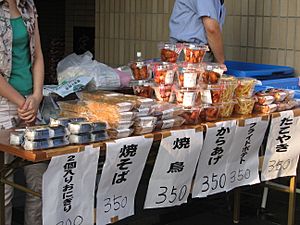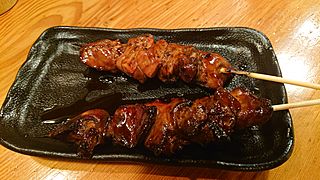Yakitori facts for kids
Yakitori (Japanese: 焼き鳥) (meaning 'grilled bird') is a popular Japanese dish. It's made from chicken pieces put on a skewer. These skewers are called kushi and are usually made of steel or bamboo. After the chicken is on the skewer, it's cooked over a hot charcoal fire. People often add special sauces or salt to the yakitori while it cooks or right after. Sometimes, the word yakitori is used for any grilled food on a skewer, not just chicken.
Contents
How Yakitori is Made
Yakitori is usually cooked in a way that makes it easy to eat on the go. Long ago, people used small, portable charcoal grills. Today, street food vendors called yatai still use these. Restaurants might use bigger, fixed grills. They often use a special, high-quality charcoal called binchōtan.
At home, people use small electric grills. These are sometimes called "mini grillers" or "yakitori devices." They work like a small oven or toaster to cook the food.
To make sure the chicken cooks evenly, it's cut into small, similar-sized pieces. Then, these pieces are put onto the kushi skewers. After that, the yakitori is seasoned and cooked. Charcoal is the best way to cook yakitori. It gets very hot and creates strong flames. It also doesn't release much water vapor. This helps the food cook quickly and makes the chicken skin crispy. Gas or electric grills can be used, but they don't give the same great smell or texture as charcoal.
Yakitori Seasonings
Yakitori usually has one of two main flavors: salty or salty-sweet. The salty kind is often seasoned with just plain salt. For the salty-sweet flavor, a special sauce called tare is used. This sauce is made from ingredients like mirin, sake, soy sauce, and sugar. Other common spices that people add include powdered cayenne pepper, shichimi (a mix of seven spices), Japanese pepper, black pepper, and wasabi. You can choose what you like best!
Where to Buy Yakitori
Yakitori-ya (焼き鳥屋) are small shops that specialize in yakitori. Many of these shops are just for take-out food. But there are also sit-down restaurants and even restaurant chains that sell yakitori.
You can find yakitori in many places, not just special shops. It's often on the menu at izakaya, which are Japanese pubs. You can also buy it already cooked, frozen in vacuum packs, or even in a can! Hotei Foods Corporation was the first company to sell canned yakitori in 1970. By 2016, they had nine different flavors. Their TV commercial song is very famous in Japan.
Yakitori is also a very popular street food. It's easy to make and carry around. You often see it sold from small carts and stalls called yatai. These yatai are found at festivals or on busy streets in the evening. People often enjoy yakitori with beer or sake.
Popular Yakitori Types
There are many different kinds of yakitori because of how they are cut and prepared. Here are some popular examples:
- momo (もも), chicken thigh
- hasami (はさみ), gizzard and spring onion
- sasami (ささみ), breast meat
- negima (ねぎま), chicken and spring onion
- tsukune (つくね), chicken meatballs
- (tori)kawa ((とり)かわ), chicken skin, grilled until crispy
- tebasaki (手羽先), chicken wing
- bonjiri (ぼんじり), chicken tail
- shiro (シロ), chicken small intestines
- nankotsu (なんこつ), chicken cartilage
- hāto / hatsu (ハート / ハツ) or kokoro (こころ), chicken heart
- rebā (レバー), liver
- sunagimo (砂肝) or zuri (ずり), chicken gizzard
- toriniku (鶏肉), all white meat on skewer
- yotsumi (四つ身), pieces of chicken breast
Gallery
See also
 In Spanish: Yakitori para niños
In Spanish: Yakitori para niños









